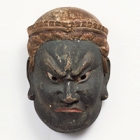Japanese Gallery (Honkan) Room 14
March 25, 2014 (Tue) - June 8, 2014 (Sun)
Masks, which have been made in various shapes around the world, transform a person into someone different. However, there are probably no countries with as many existing ancient masks as Japan. Masks were used in places of worship such as temples and shrines, at festivals to pray for harvests, or on stage to entertain. Even now, ancient masks are carefully preserved at shrines and temples across Japan.
This exhibition displays Japanese masks mainly from the Heian period (794-1192) to the Nanbokucho period (1333-1392).
Bugaku masks are used in bugaku, a performing art that prospered from the Heian period onward and which features dance together with court music. The music and dance of bugaku originated in China, the Korean peninsula, Vietnam and other places, from where it developed at the Japanese imperial court. Owing to this origin, bugaku is characterized by refined, stately movements.
Gyodo masks were worn to represent Shinto deities parading around palanquins for gods, or to perform as the twenty-five bodhisattvas who accompany Amida Buddha (Amitabha) to meet the dead in raigo-e memorial services. Raigo-e services are still held at such places as Taimadera temple, Nara, and Kuhonbutsu Joshinji temple in Setagaya ward, Tokyo.
Tsuina masks are used in tsuina-e services held on the last day of winter in the old Japanese calendar (normally February 3 or 4) to drive away evil spirits. When beans are scattered in this service, tsuina masks are worn to play the frightened ogres.
This exhibition displays the sculptural appeal of Japanese masks, as well as the methods for creating movable expressions, eyes, noses, and jaws.
Gigaku masks are also on display in the Gallery of Horyuji Treasures (until April 13).

